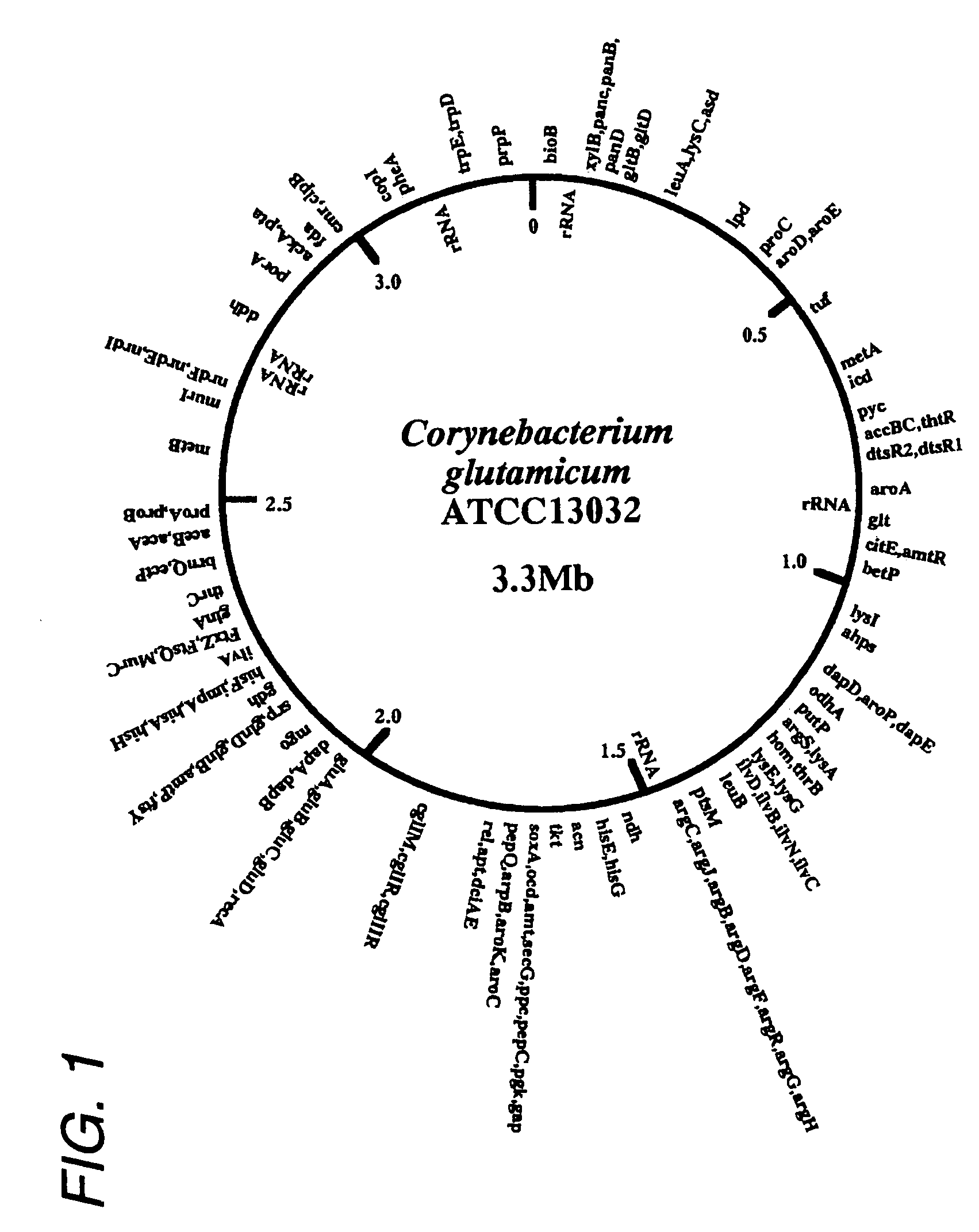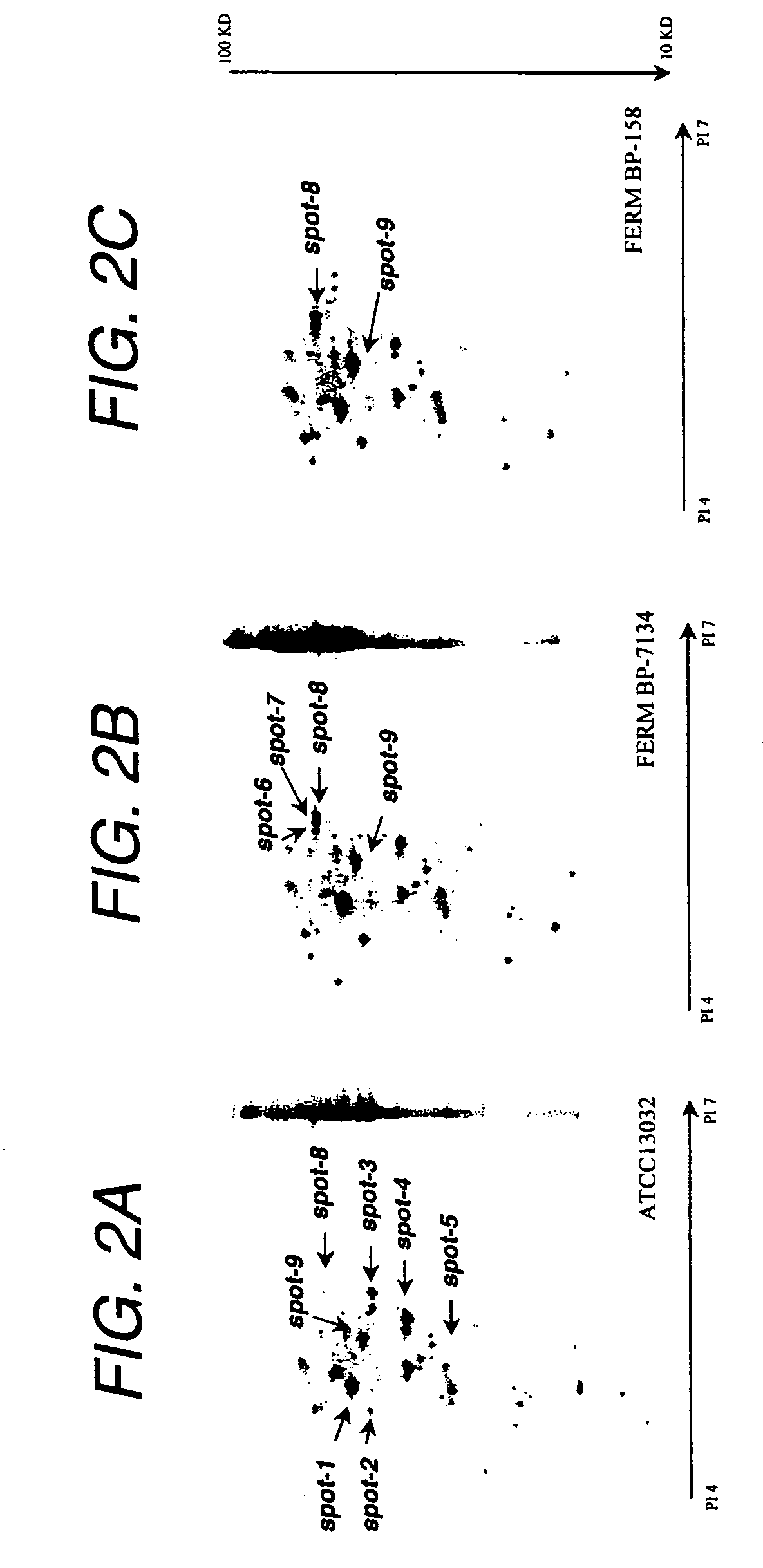Mutant of homoserine dehydrogenase from Corynebacterium and DNA encoding thereof
a technology of homoserine dehydrogenase and dna encoding, which is applied in the field of polynucleotides, can solve the problems of insufficient accumulation of basic genetic, biochemical and molecular biological data on coryneform bacteria, and the inability to sequence nucleotides
- Summary
- Abstract
- Description
- Claims
- Application Information
AI Technical Summary
Benefits of technology
Problems solved by technology
Method used
Image
Examples
example 1
Determination of the Full Nucleotide Sequence of Genome of Corynebacterium glutamicum
[0512]The full nucleotide sequence of the genome of Corynebacterium glutamicum was determined based on the whole genome shotgun method (Science, 269: 496-512 (1995)). In this method, a genome library was prepared and the terminal sequences were determined at random. Subsequently, these sequences were ligated on a computer to cover the full genome. Specifically, the following procedure was carried out.
(1) Preparation of Genome DNA of Corynebacterium glutamicum ATCC 13032
[0513]Corynebacterium glutamicum ATCC 13032 was cultured in BY medium (7 g / l meat extract, 10 g / l peptone, 3 g / l sodium chloride, 5 g / l yeast extract, pH 7.2) containing 1% of glycine at 30° C. overnight and the cells were collected by centrifugation. After washing with STE buffer (10.3% sucrose, 25 mmol / l Tris hydrochloride, 25 mmol / l EDTA, pH 8.0), the cells were suspended in 10 ml of STE buffer containing 10 mg / ml lysozyme, follow...
example 2
Determination of Effective Mutation Site
(1) Identification of Mutation Site Based on the Comparison of the Gene Nucleotide Sequence of Lysine-Producing B-6 Strain with that of Wild Type Strain ATCC 13032
[0547]Corynebacterium glutamicum B-6, which is resistant to S-(2-aminoethyl)cysteine (AEC), rifampicin, streptomycin and 6-azauracil, is a lysine-producing mutant having been mutated and bred by subjecting the wild type ATCC 13032 strain to multiple rounds of random mutagenesis with a mutagen, N-methyl-N′-nitro-N-nitrosoguanidine (NTG) and screening (Appl. Microbiol. Biotechnol., 32: 269-273 (1989)). First, the nucleotide sequences of genes derived from the B-6 strain and considered to relate to the lysine production were determined by a method similar to the above. The genes relating to the lysine production include lysE and lysG which are lysine-excreting genes; ddh, dapA, hom and lysC (encoding diaminopimelate dehydrogenase, dihydropicolinate synthase, homoserine dehydrogenase and...
example 3
Reconstruction of Lysine-Producing Strain Based on Genome Information
[0561]The lysine-producing mutant B-6 strain (Appl. Microbiol. Biotechnol., 32: 269-273 (1989)), which has been constructed by multiple round random mutagenesis with NTG and screening from the wild type ATCC 13032 strain, produces-a remarkably large amount of lysine hydrochloride when cultured in a jar at 32° C. using glucose as a carbon source. However, since the fermentation period is long, the production rate is less than 2.1 g / l / h. Breeding to reconstitute only effective mutations relating to the production of lysine among the estimated at least 300 mutations introduced into the B-6 strain in the wild type ATCC 13032 strain was performed.
(1) Identification of Mutation Point and Effective Mutation by Comparing the Gene Nucleotide Sequence of the B-6 Strain with that of the ATCC 13032 Strain
[0562]As described above, the nucleotide sequences of genes derived from the B-6 strain were compared with the corresponding...
PUM
 Login to View More
Login to View More Abstract
Description
Claims
Application Information
 Login to View More
Login to View More - R&D
- Intellectual Property
- Life Sciences
- Materials
- Tech Scout
- Unparalleled Data Quality
- Higher Quality Content
- 60% Fewer Hallucinations
Browse by: Latest US Patents, China's latest patents, Technical Efficacy Thesaurus, Application Domain, Technology Topic, Popular Technical Reports.
© 2025 PatSnap. All rights reserved.Legal|Privacy policy|Modern Slavery Act Transparency Statement|Sitemap|About US| Contact US: help@patsnap.com



